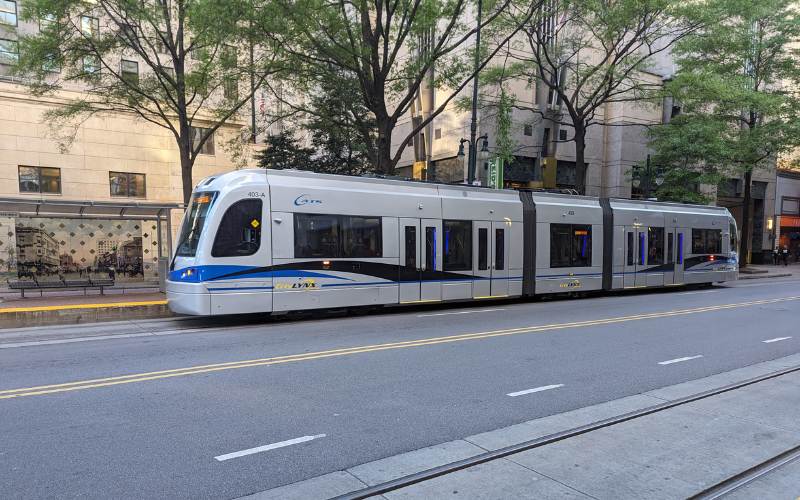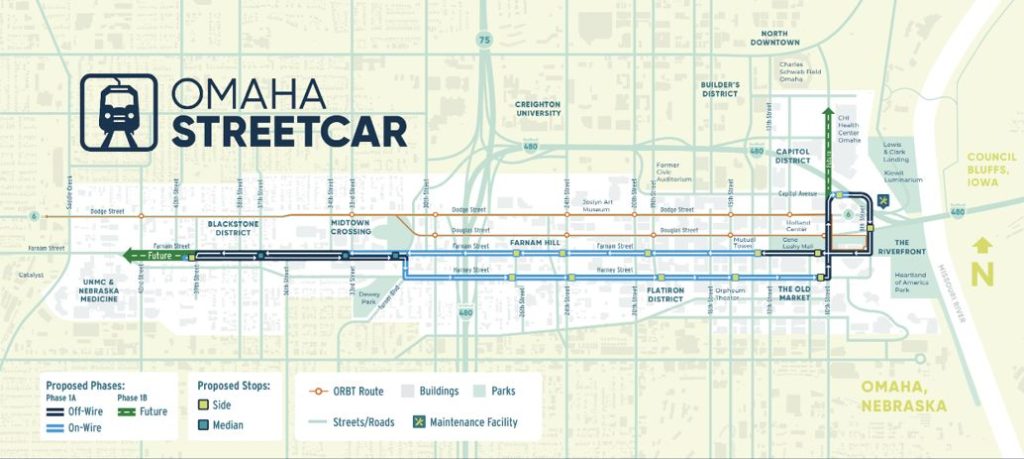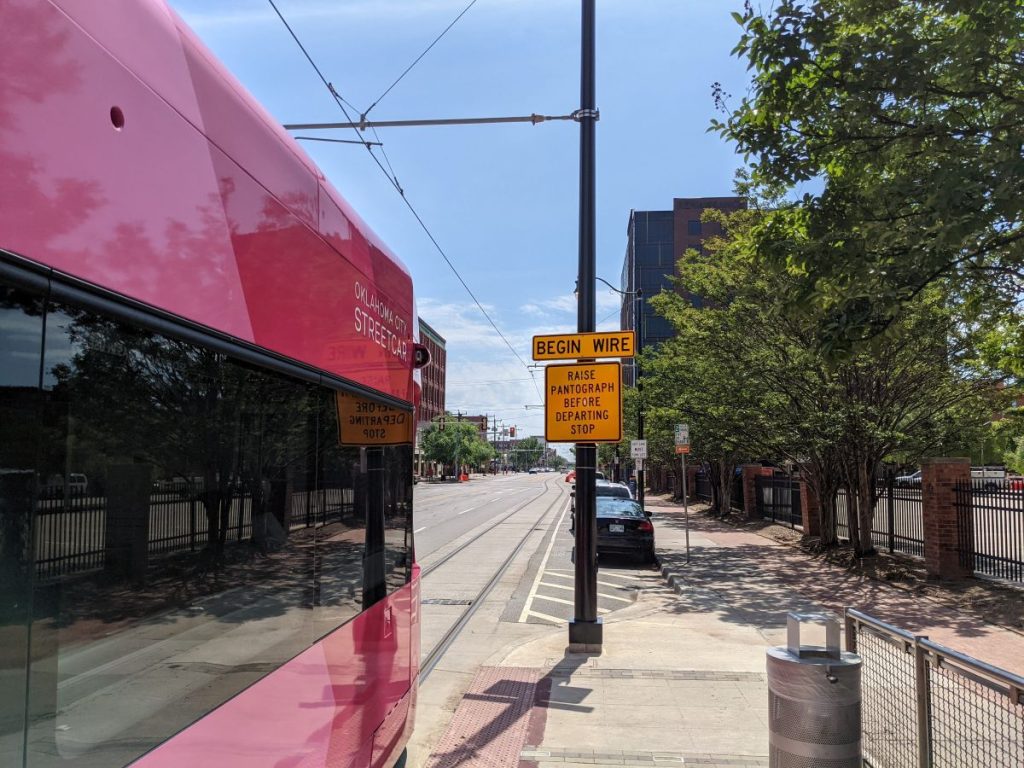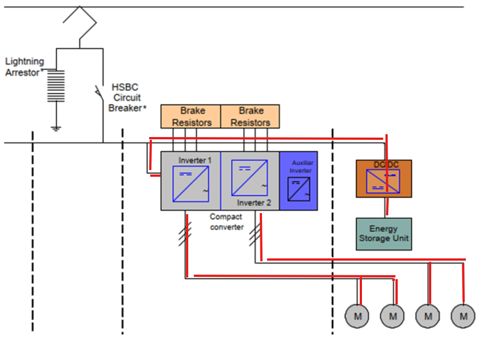A deeper look at how Omaha’s streetcars will operate half the route off-wire

Photo of a Charlotte Streetcar Off-Wire
As discussed in a previous Grow Omaha article, Omaha’s streetcar vehicles take advantage of some of the latest technology in rail transit. At the core, the streetcar vehicle is a solid piece of transit mobility that has been around for about 150 years. Over that time, there have been myriad changes and improvements to make streetcars one of the most high-tech transport vehicles out there. This article focuses on a key technology component of the Omaha vehicles: the ability to operate without being connected to an overhead wire – in essence, cutting the cord.
The Omaha Streetcar Authority (OSA) is having six new streetcar vehicles built by Construcciones y Auxiliar de Ferrocarriles (known as CAF) to provide service on the Harney/Farnam corridor, planned to begin in the Fall of 2028. The 10-minute service most of the day will require four cars, with two spares used for routine maintenance and unplanned service disruptions.
The CAF Urbos 3 cars are similar to the streetcars recently purchased by Cincinnati (a fleet of five) and Kansas City (now up 14 total cars) except for one important difference: the Omaha cars take advantage of an “Onboard Energy Storage System” (OESS), where on-board batteries are able to power the car for a period of time without having to be in contact with an overhead wire. This technology is a recent trend for all types of transportation vehicles, including buses and other rail transit cars. Cities with streetcars that use OESS include Oklahoma City, Detroit, Milwaukee, Dallas, Tempe and Charlotte. Most of these cities use streetcar vehicles built by Brookville, except Charlotte, which has a Siemens vehicle. Omaha will be the first OESS vehicle for CAF in North America.
What’s New with Omaha’s Streetcar Vehicles
At a recent town hall, Mayor John W. Ewing, Jr. proclaimed that Omaha should have started building streetcars when first proposed by then-Mayor Hal Daub in the 1990s. While I don’t disagree with that (think of the potential rail transit system we could have today if we started back then!), our later start to the light rail/streetcar game allows us to take advantage of new technology that was not available back then. While off-wire technology was breaking new ground about a decade before, it is more commonplace and standard now, with better lithium-ion batteries and a greater understanding of how this technology works and needs to be maintained. The systems have developed to be robust enough to provide dependable transit operations throughout the day (18-20 hours) while running every 10 minutes for most of that time, providing service for thousands of passengers every day.
For Omaha, the streetcar route will take advantage of off-wire running on the east and west ends of the system, while the center section, the part with the most hills, will be connected to the overhead wire. The wired section will run from 14th & Farnam Street to 33rd & Farnam Street westbound and from Turner Boulevard & Farnam Street to 10th & Harney Street eastbound. The map below shows the off-wire segments in dark blue.

Map of the Initial Omaha Streetcar Line Showing On- and Off-Wire Segments
Additionally, there will be charging stations at each end-of-line stop: at the planned 40th & Farnam stop and at the 8th & Capitol Avenue stop. The streetcar vehicle will automatically raise and lower the “pantograph,” which is the mechanism that sits atop the streetcar vehicle and connects to the overhead wire. The 8th & Capitol stop may not be used too often for on-route charging, as it is planned to keep running through the loop with only a dwell to let passengers on and off. At this stop, the operator will need to manually raise the pantograph if there is extra time in the schedule, while the vehicle will automatically lower the pantograph as the vehicle begins to depart from the stop. At the 40th & Farnam stop, and the other stops in between, the vehicle will automatically raise and lower the pantograph according to the position that it needs to be in – raised to connect to the wire or charging location and lowered when there is not a wire overhead.
Building a streetcar system without wires in some locations provides multiple benefits. An obvious reason is the cost savings associated with not having to build poles and wire along part of the route. Related to this, there is simplicity in not having to make clearances along the alignment for the wire in this portion, and the streetcar can operate under lower overhead structures.

A Stop on the Oklahoma City Streetcar System Where the Wire Begins Again
So now you may be thinking, “This is all great, but why not just run the entire system without wires and go totally battery powered like electric-powered buses?” That is a great question, and the short answer is that rail vehicles need more power than buses because of their size and weight. Plus, there is not enough space on board to include batteries for all-day operation. This is specifically important for transit systems, as rail vehicles are traditionally in service for nearly 20 hours, running continuously for most of that time.
Most battery-powered electric buses only run in service for four-to-eight hours and then go back to the garage for charging or have longer layovers at terminals with charging stations. Many rail transit systems do not operate with peaks in service, where a vehicle is only out for a few hours of the day to cover the most popular commute times. Rather, most rail systems run the same frequency throughout the day. Therefore, the ability to provide charging on the route is essential to keep enough power going into the vehicle and recharging the batteries so that it works through the off-wire sections.
Another question that you may think about – How long do these batteries last, and doesn’t all this constant charging deplete their life quickly, like on my phone? The batteries should last about 10 years before needing to be replaced. Batteries should be able to be swapped out a few times during the life of a car, similar to other components when vehicles are due for a long-term overhaul (usually after 20 years). Transit vehicle batteries have improved over the last decade and are lasting longer now. Traditionally, systems that operate in colder climates need to replace their batteries sooner. For example, Milwaukee replaced the batteries in its streetcar vehicles earlier this year. These vehicles were completed and put into service in early 2018 (their system opened to the public in November 2018). Oklahoma City had its vehicles built by the same manufacturer and at about the same time, but it is not yet considering replacing its batteries. Omaha should be somewhere in the middle, and again, our batteries should last a little longer as we can take advantage of having almost another 10 years of technology improvements.
How the Technology Works
Battery-powered operation is very similar to a technology that has been in use on rail vehicles for decades: regenerative braking. This is essentially taking power generated by the streetcar vehicle when braking is applied (such as going downhill) and putting the power back into the system. In this case, the streetcar vehicle uses regenerative braking to put power back into the batteries, in addition to the rest of the electrical system. When the streetcar vehicle is unattached from the wire, power comes out of the batteries.
The diagram below shows how power moves from the batteries (Energy Storage Unit), then through the usual Inverters (which convert the power from DC to AC), and then to the wheels (the four “Ms” in the diagram, representing each vehicle axle) to propel the vehicle forward. When connected to the wire, the power source switches to coming directly from the overhead wire and then proceeds through the same inverters and then to the wheels to propel the vehicle. The batteries are charged by both regenerative braking and from the overhead wire.

Diagram Illustrating How Power Moves from the Batteries (Energy Storage Unit) to Propel the Wheels
As you start to see the actual construction of the streetcar system next year, be sure to look up and take note the areas are that do and don’t have electrical wire. And as our vehicles start testing in about two years, be sure to look above the roof and see if the pantograph is raised and connected to the wire or lowered and operated off-wire. It will be exciting to see this technology in use in Omaha as we are able to cut the cord in some locations!
